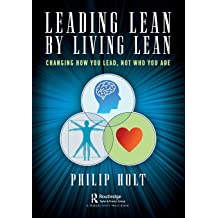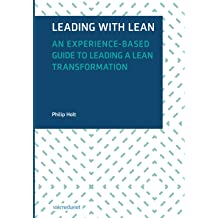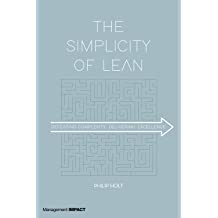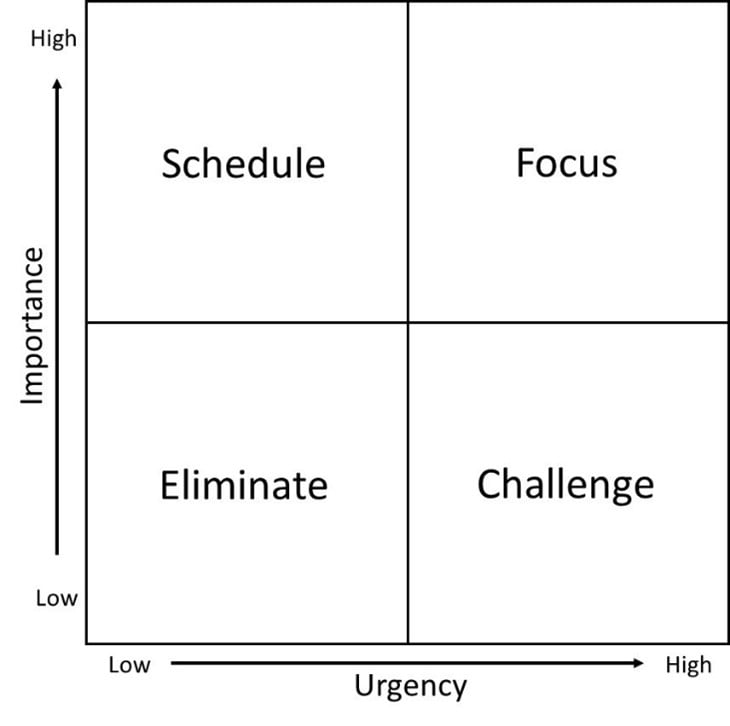Living Lean
Oct 31, 2022
Lean is probably one of the most misunderstood leadership concepts in business, and many people would even question why I would refer to it as a leadership concept. Surely it’s a manufacturing methodology, hence why it’s often referred to as Lean Manufacturing and is the descendent of the Toyota Production System (TPS)?
Somehow, and despite the many practitioners, academics and consultants whom collectively have sought to understand, codify and teach the lessons and best practices of Lean Leadership, in my experience the majority of people still have a woefully inadequate comprehension of what it really means to live, practice and succeed with Lean, spending an inordinate amount of time running tool based, point improvement activities, and completely missing the holistic cultural transformation necessary for an organization to be able to emulate the truly Lean enterprises.
However, this is precisely why books like “Leading Lean by Living Lean“, over 30 years after The Machine that Changed the World was first published, are so necessary.



With Leading Lean by Living Lean, I’ve detailed out what is probably the most important part of becoming a Lean Leader, which is living and practicing what you preach. To do this you must believe in what you’re doing, understand what it means and what you need to do, and then really do it every day. In this regard I’ve been influenced by David Bovis, and in particular his Believe-Think-Feel-Act (BTFA) model, which has helped the engineer in me, comfortable with the Plan-Do-Check-Act (PDCA) model of Deming / Shewhart, to understand why logic and facts are very often not the principal players in the game of change.
The Urgency – Importance matrix
One of your biggest challenges to Living Lean will be the daily test of deciding what you should be spending your time on. The way of thinking and the tools that I’ve described are all designed to support you in ensuring that you spend your time on the important elements of your life and not the insignificant things that waste your time and detract from its meaning. For many people the driver of their activity is whatever the latest request is to them, particularly if it’s from their boss. Therefore they are significantly driven by email coming at them, an ad hoc call, or the latest meeting that they attended. They start the day with a plan, the first ‘shot of battle’ is fired, and their day ends after a whirlwind of activity but with little of their original plan completed.
Does that sound like many of your days? If so there’s a danger that you’ve become caught in the urgent – important trap and that this conflict is having a deleterious impact on your daily professional and personal life. As I’ll discuss in the next section, to some this is actually a reassuring feeling, as in the short-term it’s simpler and easier than the alternative of running a planned and organized day, focused on delivering what really matters.

The Urgency – Importance matrix is well known and used extensively by many, although I’ve amended it slightly from the normal illustration in two ways:
- Instead of Do and Plan for the important activities, I’ve called them Focus and Schedule.
- Instead of Delegate for the low importance, high urgency activities I’ve called it Challenge.
The reason for the first change is that I believe that you can live a life whereby you reduce the important – urgent items to only those that you are focusing on in your personal Kanban, and have those important items not yet urgent scheduled and ready for on-time delivery. This means that you know what you need to do, have it planned and scheduled as part of your Leader standard work, and deliver consistently what is needed at the required level of quality and on time.
Certainly there will be special cases and unanticipated issues will raise their head but, as I discuss throughout the book, this is why you want to be organized to deliver those things that you already know how to do: So that you’re in a state of readiness for the unexpected. Just as a top professional athlete has practiced the standard routines of their sport to the point that they don’t need to think about them and are able to respond quickly to their opponent’s attack, so you can be ready for the unexpected and rise to the challenge.
The intent of the second change is that the instruction to delegate the low importance, high urgency items can be dangerous and misleading. If it is really a case that these activities or tasks must be done and the level of importance is relative to whether it requires your attention or someone else’s (for example a more appropriately skilled colleague, a member of your team or another family member) then I would agree that delegate is a valid approach. However, often it is the case that the activity is actually not important at all and ought not be done and so a delegation simply gets it off your plate and onto someone else’s, which is not what we want to achieve.
Instead let’s challenge the validity of those tasks that we believe sit in the urgent – unimportant quadrant and determine whether they are necessary at all or are simply wasteful activity that should be discontinued or eradicated. Try to understand from where the urgency is manifesting itself: Is it someone senior for whom it’s a ‘pet project’ or is there a misconception in the organization about it and the perception of others is that it’s actually important? Are you wrong about it being unimportant and it actually is important and you need to reposition it in the matrix and act accordingly? Whatever the outcome, hopefully it’s clear why I think that challenge is a much better approach than to simply delegate.
In summary, the four quadrants should be dealt with in the following manner:
High importance – High urgency: Focus on these items, ensuring that they are the activities that you are working on as part of your current personal Kanban.
High importance – Low urgency: Schedule these items in your personal Kanban to ensure that you do them on time and to the right quality level, with adequate preparation and to standard.
Low importance – Low urgency: Eliminate anything in this quadrant as it shouldn’t be worked on at all.
Low importance – High urgency: Challenge the need for these activities and understand from where the urgency is manifesting itself. Determine whether it is in the correct quadrant, eradicate if possible and, if necessary, delegate it if you are not the best person to undertake it.
Lean busy or ignorant overloaded bliss
Being too busy, overloaded, is something that Living Lean aims to avoid but that shouldn’t be confused with not being busy. You will be busy executing what matters with a high degree of effectiveness but taking adequate breaks and completing your work in time to also spend personal time on what matters to you.
However, for people in the early stages of their transition, the perception can be different. A good example of this is that for many people on their Lean journey a great way of seeing what world class looks like is attending best practice visits to operationally excellent companies on Benchmarking, or Kaikaku, experiences. However, one consistent feedback that I receive from participants, especially those to Toyota, is that they are impressed but:
“I wouldn’t want to work there.”
When this is probed further, the underlying reason is that they observe team members who appear to be constantly busy and that the work must be tiring and monotonous, working to the cadence of their standard work, whether operator, support staff or managerial, all aligned to the Takt time of the customer demand. This is always intriguing to me as, over the many years of practicing Lean leadership and studying many world class organizations, I have come to the conclusion that the real issue is that Lean organizations ‘make problems visible’, the problem in this case being that to be a world class organization it takes focused, deliberate and consistent effort to meet a customers’ sustainability, innovation, quality, cost and delivery requirements.
In these operationally excellent organizations the magnitude of the task, and the way that it is solved, are blatantly obvious to all, and their people are trained and engaged in being up to the task. Just like a top performing sports team, they know that it takes training, hard-work, persistence and innovation (Kaizen) to succeed, and they all understand their ‘field position’ in the team’s success.
Contrast that with a traditionally managed organization, where processes are loose and ambiguous, standards weakly applied and competence development poor. In those organizations the solution to the problem of meeting their customers’ needs is not so obvious, and people have much more perceived autonomy to do the job at their own pace. However, the irony is that when I discuss the biggest issues that people have in traditional organizations, it is their overload: Long hours, stress, too many meetings to attend, continually having to deal with recurring problems.
The very symptoms that they perceive to exist in Lean organizations are the very symptoms that they acutely suffer from in their own organization. There is certainly a perception versus reality conflict in terms of how people are unable to see the freedom that these Lean organizations create for the people who work there.
For many, the reality of being ‘Lean busy’ is undesirable compared to the ignorant bliss of the overload in their traditional organizations and in my experience this is a significant barrier for many organizations in their Lean transformations. However, before that it begins with the individuals, with you the readers and your own battle with the recognition of the many benefits that a change in your way of working, to a more structured and coordinated approach, will provide you with the time to spend on the things that really matter to you.
Living Lean
As you practise Living Lean you’re going to be on a roller coaster ride of highs and lows. Will you have the stamina to see it through or will it become too much of a change to be able to keep it going and you’ll find that you revert to your ‘normal’ behaviours? It isn’t easy and as you go through this you’ll probably observe, as I often do, that even those people with Lean, Continuous Improvement, Six Sigma or Operational Excellence in their job title don’t often actually operate in the way that they teach and coach others to do. In fact, I’ve met a number of Lean consultants whose working practices could benefit from Living Lean!
For those of you who stay on the track, your colleagues, friends and family will ask you how you managed to complete that report so quickly or solve that problem so rapidly. “How do you manage to get so much work done, you must be working long hours?” will be a question that you hear regularly, although that won’t be the case because you will have increased the amount of your time that adds value instead of increasing the hours that you work.
I’ve been practicing Lean for longer than I’ve been living it and I can honestly tell you that I only really got to the point that I could consider myself an expert worthy of advising others when I truly started to “practice what I preach” and “Walk the Talk”. We’ve all heard the story of the Doctor who drinks too much Scotch Whiskey or the Police Officer who drinks and drives but do we really want to be coached by a Lean expert who works in a traditional manner?
However, the point of this article isn’t to look outwardly but inwardly and what I hope that it has helped you to think about is how Living Lean can help you to meet your personal improvement goals and to live both your personal and professional life in the way that you want to do. To achieve this you’ll need to have the knowledge, skills and desire to do it and I can, through my articles and books, help you with the knowledge, following the advice and practising will help you with the development of the skills but, ultimately, it will rest on you having the continued desire to make the change.
We talk a lot about a life in balance but perhaps we should, instead, think about the rhythm of our lives; instead of balancing the content of our life, we should ensure that we create a daily, weekly, monthly rhythm that works within our physical, mental and financial limits. If we’re not careful, we can easily continue to balance our life scales until there’s a massive load on each side, ultimately breaking and collapsing under the total weight.
However, if we think about creating rhythm, we should be able to quickly identify when we’re ‘out-of-tune’ and do something about it. Perhaps think about that in your Hansei and consider how thinking differently about your life’s ‘Takt’ could liberate the way that you deal with it.
I sincerely hope that this article has helped you to decide upon the next step in your personal development and I would encourage you to read further in Leading Lean by Living Lean. However, before I finish this article, I want to ensure that I haven’t given you the wrong message. Living Lean isn’t a ‘one size fits all’ approach to your personal and professional life and the way that I do it is most likely not going to work for you.
I’ve written Leading Lean by Living Lean to share my knowledge and experience with others, in the sincere belief that this will help them to work and live better and make their, and by extension our, world a little bit better. I therefore really hope that you’ve gained the inspiration to investigate further how to achieve this end and I’d really like to know how it has impacted you, which you can most easily do via LinkedIn or via my website; leadingwithlean.com.
Whatever you’ve taken from this article, I’m firstly pleased that you’ve made it to the end and secondly hope that what you’ve taken from it will help you to change how you lead, but not who you are!
About the Author
Philip Holt is currently Senior Vice President, Operational Excellence at GKN Aerospace, the world’s leading multi-technology tier 1 Aerospace supplier. He was formerly Vice President, Continuous Improvement at Travelport, a leading Travel Commerce Platform, and prior to that held a number of senior Lean Leadership roles with Royal Philips, most notably Head of Continuous Improvement for Philips, Head of Continuous Improvement for the Consumer Lifestyle sector, and Head of Operational Excellence, Accounting Operations. Philip was the lead author of the Philips Lean Excellence Model.
Philip has over 30 years of business experience in leadership roles spanning the customer value chain, in Industry Leading Companies such as GKN Aerospace, Philips, Gillette, and Travelport. During this time he has built up an impressive reputation in Lean Leadership practices and is a regular speaker at industry conferences.
He studied at Manchester Metropolitan University, Warwick Business School, and the University of Pennsylvania (Wharton School).
Living Lean: Doing it right; Doing it well is his third book, following the Axiom 2020 Business Book Awards Bronze Medal winner, The Simplicity of Lean: Defeating Complexity; Delivering Excellence and the success of Leading with Lean: An Experience-based guide to Leading a Lean Transformation.
Original Article: https://opexsociety.org/body-of-knowledge/living-lean/
Stay In Touch.
Subscribe to our newsletter and exclusive Leadership content.
